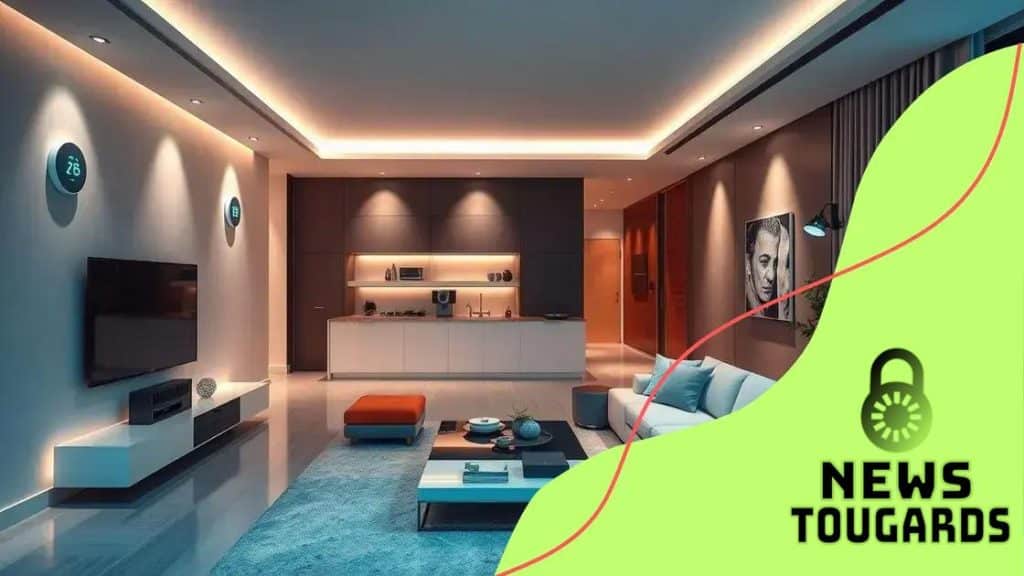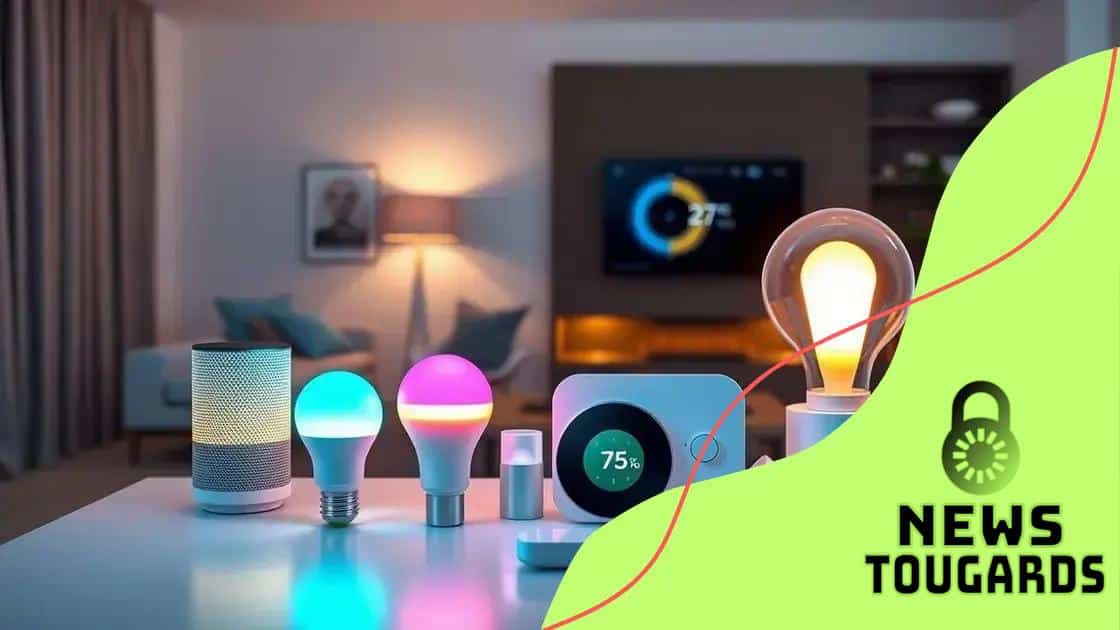How the Internet of Things (IoT) is transforming homes

The Internet of Things (IoT) is transforming future homes by enhancing convenience, improving energy efficiency, securing environments, and anticipating user needs through smart device integration and automation.
How the Internet of Things (IoT) is shaping future homes opens up a world of possibilities for both comfort and convenience. Just imagine controlling your lights, thermostat, and security systems all from your smartphone. Intrigued yet?
Understanding the Internet of Things (IoT)
The Internet of Things (IoT) is a revolutionary network connecting various devices, allowing them to communicate and share data. This technology integrates everyday objects with the internet, making life easier and more efficient.
What is the IoT?
In simple terms, the IoT refers to the interconnection of devices via the internet, enabling them to send and receive data. Examples include smart home appliances, wearables, and even smart city infrastructure. For instance, your refrigerator can notify you when you’re running low on groceries, and your thermostat can optimize energy use based on your routine.
Key Features of the IoT
- Seamless connectivity between devices
- Data collection and analysis for better decision-making
- Automation of everyday tasks
- Remote monitoring and control of devices
This interconnectedness promotes a smarter lifestyle. With the IoT, homes can become more efficient and secure. For example, enhancing your security system with IoT devices can provide real-time alerts and monitoring from anywhere. Imagine receiving instant notifications on your phone if someone is at your front door.
Benefits of Using IoT
Another aspect of the IoT is the significant benefits it brings. Improved efficiency leads to reduced energy consumption. Smart meters track usage, helping homeowners cut costs and minimize waste. Additionally, IoT devices help maintain comfort with adjustable settings, catering to your specific needs.
The Internet of Things is not just a trend; it is reshaping how we interact with our environment. As technology advances, you can expect even more innovative solutions that enhance daily living and provide valuable insights into our habits and preferences.
Key benefits of IoT in residential settings
The Internet of Things (IoT) brings significant advantages to residential settings, transforming how we live and interact with our homes. These benefits range from convenience to energy efficiency, enhancing our daily lives.
Enhanced Convenience
One of the primary advantages of IoT is the convenience it offers. Smart devices, like voice-activated assistants, allow you to control various elements of your home with just your voice. You can adjust the lights, play music, or set the temperature without moving from your seat. Imagine waking up in the morning and already having your coffee brewed and waiting for you.
Energy Efficiency
Another major benefit of IoT is energy efficiency. Smart thermostats can learn your schedule and adjust heating or cooling based on when you’re home. This automation not only keeps you comfortable but also saves energy and reduces utility bills. Additionally, smart lighting systems can turn off automatically when you leave a room, ensuring that no energy is wasted.
- Real-time monitoring of energy consumption
- Automated control of heating and cooling systems
- Reduced energy waste with smart appliances
The IoT also improves home security. Smart security cameras and door locks provide real-time alerts to your smartphone, ensuring peace of mind whether you’re home or away. You can monitor your home from anywhere, giving you the ability to respond quickly to any unusual activity.
Increased Safety and Security
Moreover, devices like smoke detectors and carbon monoxide alarms can notify you instantly in case of danger. With remote access to your security system, you can check in on your home anytime, which adds an extra layer of safety.
In summary, the key benefits of IoT in residential settings include enhanced convenience, energy efficiency, and increased safety and security. Through smart technology, our homes are becoming more efficient and responsive, ensuring a better quality of life.
Smart devices and their integration

Smart devices are a crucial component of the Internet of Things (IoT), transforming how we interact with our homes. These devices communicate with each other, creating a seamless network that increases efficiency and convenience in daily tasks.
Types of Smart Devices
Some common smart devices include smart speakers, smart lights, and smart thermostats. Each device plays a unique role in enhancing the home experience. For example, smart speakers can control other devices via voice commands, providing hands-free operation.
Integration of Smart Devices
The integration of these devices is vital for a connected home. Systems like Google Home or Amazon Alexa allow different smart devices to work together. You can use voice commands to control the lights, music, and temperature all in one go. This integration simplifies managing your home, making it more user-friendly.
- Interoperability allows devices from different brands to connect.
- Automated routines can be set for mornings and evenings.
- User-friendly apps provide centralized control.
The integration also means that smart devices can learn from your habits. For instance, a smart thermostat can adjust based on your daily patterns, ensuring comfort while saving energy. Additionally, smart security systems can respond automatically to potential threats, offering enhanced safety.
The Future of Smart Device Integration
Looking forward, we can expect even more advancements in smart device integration. As technology continues to evolve, the capabilities of these devices will expand, offering even more features and better performance. This evolution will make our homes not just smarter, but also more intuitive and responsive to our needs.
Securing your IoT-enabled home
Securing your IoT-enabled home is crucial as we embrace smart technology. With various connected devices in our homes, ensuring their security helps protect our privacy and safety.
Understanding Potential Threats
The first step is understanding the potential threats that these devices may face. With every smart device connected to the internet, there is a risk of hacking. Cybercriminals can exploit vulnerabilities in poorly secured devices to gain access to your personal information.
Best Practices for Security
Implementing robust security measures is essential for protecting your smart home. Here are some important practices:
- Change default passwords: Always change the default passwords on your devices to unique, strong passwords.
- Regularly update firmware: Keep your devices up to date with the latest firmware to protect against known vulnerabilities.
- Use a secure Wi-Fi network: Make sure your home network is secure, using strong encryption protocols.
- Enable two-factor authentication: Whenever possible, use two-factor authentication for an added layer of security.
Maintaining an awareness of potential threats is key. Regularly check for updates related to your devices and stay informed on the latest security features.
Using a Dedicated Network
Creating a dedicated network for your smart devices can also enhance security. By isolating IoT devices on a separate network, you minimize the risk of breaches affecting your main devices like computers and smartphones. This measure adds an extra layer of protection, ensuring your sensitive information remains safe.
Securing your IoT-enabled home not only protects your data but also contributes to a smoother, safer experience with smart technology. With the right precautions, you can enjoy the benefits of IoT while keeping your home secure.
Future trends in home automation
The future trends in home automation are exciting and filled with possibilities. As technology advances, we can expect our homes to become increasingly intelligent and responsive to our needs.
Enhanced Connectivity
One significant trend is enhanced connectivity among devices. As more devices become part of the Internet of Things (IoT), they will seamlessly communicate with each other. Imagine a home where your refrigerator can check your pantry and suggest grocery lists based on what you need.
Artificial Intelligence Integration
Artificial intelligence (AI) will play a massive role in shaping home automation. Smart assistants will learn your habits and routines over time. They will anticipate your needs, like preparing your morning coffee when your alarm goes off. This integration of AI makes life more convenient and can optimize energy use in real-time.
- Smart lighting that adjusts based on natural light levels.
- Heating and cooling systems that learn your preferences and adjust accordingly.
- Security systems that adapt to your lifestyle and alert you about unusual activity.
Another trend is the shift towards sustainability. As homeowners become more eco-conscious, home automation will focus on energy efficiency. Smart devices can monitor energy consumption and suggest ways to reduce waste. For instance, automated systems can manage your solar panels to maximize their effectiveness.
Seamless User Experience
A seamless user experience is also on the rise. Smart home systems will become easier to control, often being managed from a single app on your smartphone. This unification simplifies how you interact with various devices. Voice control will become more refined, allowing for natural conversations with your smart home.
In essence, the future of home automation holds incredible potential. As technology continues to evolve, we can look forward to homes that not only enhance our lives but also become proactive partners in living well.
In conclusion, the Internet of Things (IoT) is transforming our homes into smart, efficient spaces that enhance our daily lives. From improved convenience and energy efficiency to enhanced security, IoT devices are reshaping how we interact with our living environments. As technology evolves, we can expect even more innovations in home automation that will make our homes more intuitive and responsive. By embracing these changes and implementing effective security measures, we can safely enjoy the comfort and benefits of a connected lifestyle.
FAQ – Frequently Asked Questions about Home Automation and IoT
What is home automation?
Home automation refers to the use of technology to control and manage household devices and systems, making them more efficient and convenient.
How do smart devices improve energy efficiency?
Smart devices can monitor energy usage and adjust settings automatically, helping to reduce electricity consumption and lower utility bills.
Are there security risks with IoT devices?
Yes, IoT devices can be vulnerable to hacking. It’s essential to follow security best practices, like changing default passwords and regularly updating firmware.
What future trends can we expect in home automation?
Future trends include enhanced connectivity between devices, greater integration of artificial intelligence, and more focus on sustainability and energy-saving technologies.





